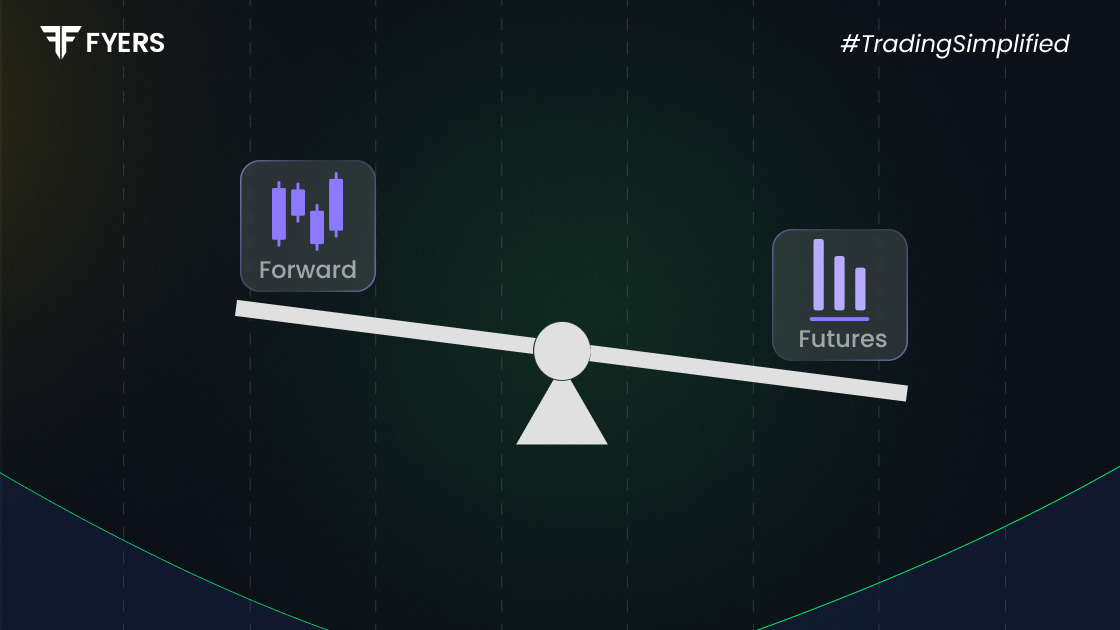

 27 Jul, 2025
27 Jul, 2025
 4 mins read
4 mins read

In the derivatives market, types of derivative contracts, such as forwards and futures, are used to manage risk or speculate on price movements. While they can seem similar, they have key differences that suit different types of investors. This guide explains the difference between forward and futures contracts.
A futures contract is a legally binding agreement to buy or sell an asset at a predetermined price on a specified future date. These contracts are standardised and traded on exchanges such as the NSE or BSE in India.
Standardised terms: The quantity, quality, and delivery time of the underlying asset are predefined.
Traded on exchanges: Offers transparency and reduces counterparty risk.
Margin requirement: Both parties must deposit a margin with the exchange, which gets adjusted daily based on market fluctuations.
Mark-to-market: Profits and losses are settled daily based on the market price.
Futures are commonly used for commodities, currencies, interest rates, and equity indices.
A forward contract is a private, customisable agreement between two parties to buy or sell an asset at a specific price on a future date. These contracts are traded over-the-counter (OTC), not on a centralised exchange.
Customisable terms: The contract can be tailored to suit the needs of both parties.
OTC trading: Exposed to counterparty risk due to lack of standardisation.
No daily margining: Settlement occurs only at the end of the contract term.
Forwards are often used by businesses for hedging against foreign exchange fluctuations or commodity price risks.
Let’s look at the forward vs futures comparison:
|
Feature |
Futures Contract |
Forward Contract |
|---|---|---|
|
Trading Platform |
Exchange traded |
OTC private agreement |
|
Standardisation |
Standardised terms |
Customised terms |
|
Counterparty Risk |
Low due to clearinghouse guarantee |
High |
|
Settlement |
Settled daily via mark-to-market |
Settled on maturity |
|
Liquidity |
High |
Low |
|
Regulatory Oversight |
Strong regulation by SEBI and exchanges |
Minimal |
|
Contract Size |
Fixed sizes |
Negotiable |
|
Use Case |
Hedging and speculation |
Hedging specific business risks |
Understanding the pros and cons of each contract helps in selecting the right one based on your needs.
Customisation allows tailored risk management.
No margin requirement, freeing up capital.
Suitable for businesses with specific hedging needs.
Counterparty risk due to lack of central clearing.
Illiquidity makes it hard to exit before maturity.
No daily settlement, which may lead to larger losses if prices move unfavourably.
Standardisation brings transparency and ease of trade.
Lower counterparty risk due to exchange involvement.
Highly liquid markets.
Daily margin calls can tie up capital.
Not flexible – standard terms may not suit everyone.
Exposure to short-term price volatility due to mark-to-market.
Forward Contract Example
An Indian rice exporter enters a forward to sell 10,000 kg of basmati at ₹80 per kg in three months. Even if the market price rises to ₹90, they must sell at ₹80. This guarantees income but could limit profits.
Futures Contract Example
A trader buys a crude oil future at ₹6,000 per barrel expecting prices to rise. If prices climb to ₹6,500, they close the contract early and make a profit. If prices fall, they incur a loss. Futures are ideal for those seeking liquidity and clear pricing.
Understanding the difference between forward and futures contracts is essential for anyone involved in derivatives. While both help manage price risk, forward and futures contract vary significantly in structure and risk:
Forwards are flexible but come with high counterparty risk
Futures offer security, high liquidity and are regulated, but less flexible
Choosing between them depends on your individual needs, risk tolerance, and preference for regulation.
The forward and futures contract differ mainly in trading mode and standardisation. Forwards are private and bespoke. Futures are standardised, exchange-traded and safer.
A futures contract is generally safer due to regulation, standard terms and clearinghouse support. Forwards carry higher counterparty risk in private deals.
Calculate your Net P&L after deducting all the charges like Tax, Brokerage, etc.
Find your required margin.
Calculate the average price you paid for a stock and determine your total cost.
Estimate your investment growth. Calculate potential returns on one-time investments.
Forecast your investment returns. Understand potential growth with regular contributions.